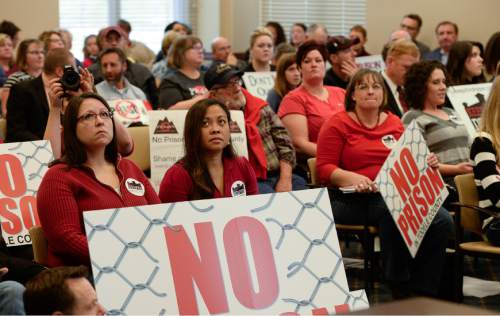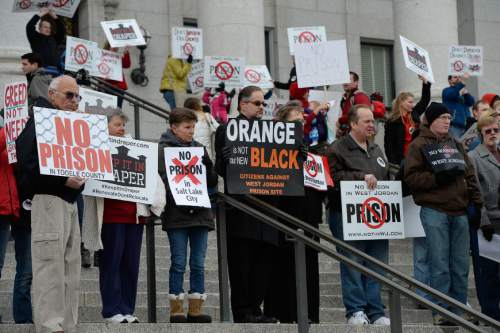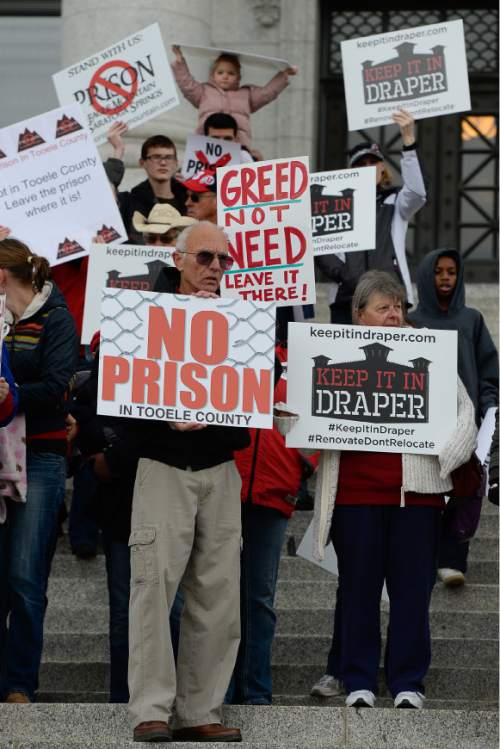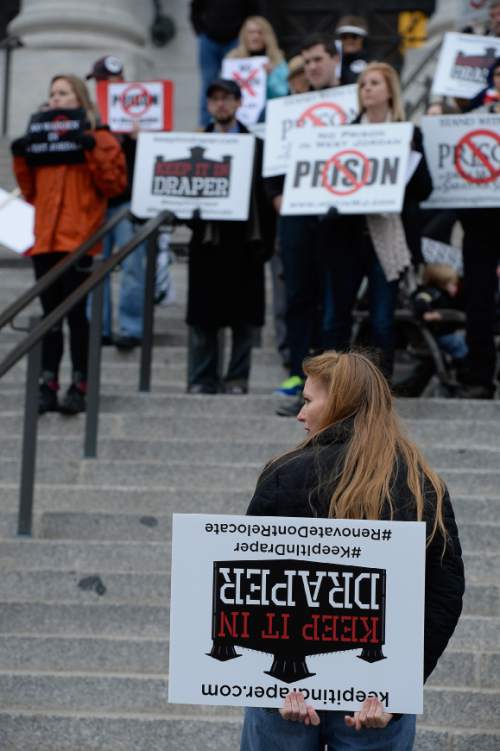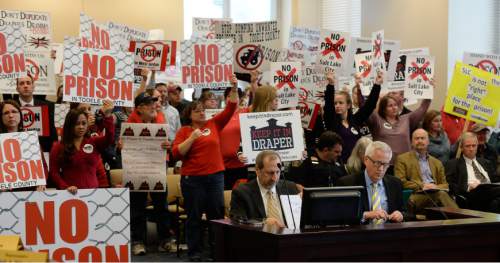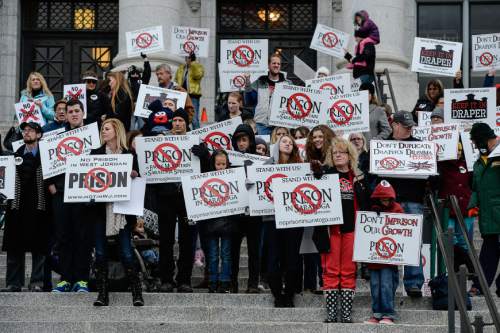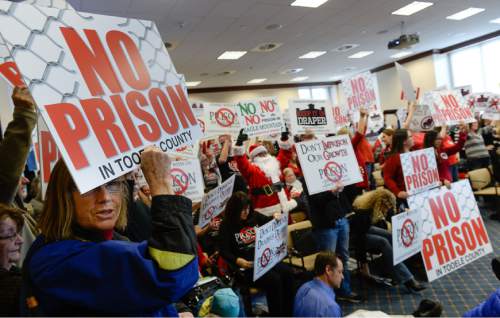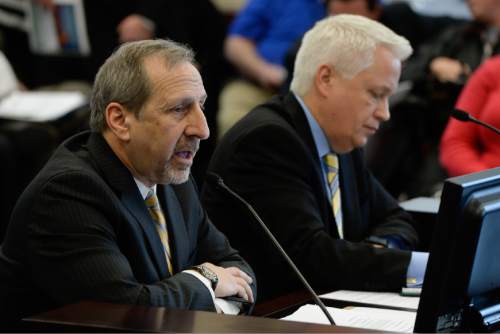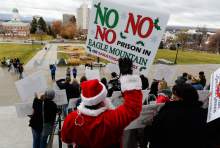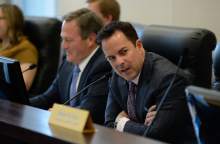This is an archived article that was published on sltrib.com in 2014, and information in the article may be outdated. It is provided only for personal research purposes and may not be reprinted.
The Prison Relocation Commission cut its short list in half Monday during a meeting where members vigorously defended plans to move the prison out of Draper, speaking directly to a crowd of frustrated protesters fearful their cities may land the controversial project.
Three sites remain — one each in Eagle Mountain, Tooele County and Salt Lake City — and three others were dropped, including one north of Salt Lake City International Airport, which contained more wetlands than the commission originally expected.
The other two, in Saratoga Springs and West Jordan, were previously removed when the owners backed out of the process, though the review by consultants suggested they wouldn't have made the cut anyway.
Sen. Jerry Stevenson, R-Layton, the co-chairman of the commission, said there's a "pretty good likelihood" the prison will end up in one of the three final sites, and yet the group of seven lawmakers who comprise the panel also agreed to review other options until the end of January.
"We are going to go out and look and see if we missed anything," Stevenson said. "There's a small chance another site could emerge."
Commission leaders have recently received proposals for additional sites in Tooele County, farther from the population base. Consultants have not had the time to fully review those locations.
"There is a lot of ground out in Tooele but if it is any better than any other ground we have looked at is yet to be determined," said Rep. Brad Wilson, R-Kaysville, the commission's other co-chairman.
Tooele County leaders are frustrated at the site now under consideration. It is located next to Miller Motorsports Park and a community recreation center and is owned by the family of Larry H. Miller.
County Commissioner Shawn Milne called it "an outright slap in the face for us," though he wouldn't close the door on moving the prison to a more remote part of Tooele County.
Salt Lake City Mayor Ralph Becker and the City Council have promised to fight any potential prison site in the capital city. The remaining Salt Lake City site is owned by Rio Tinto, the parent company of the Kennecott Copper Mine, and is located off of Interstate 80 and 7200 West.
Consultants said that land also contains some wetlands, but unlike the parcel north of the airport, they believe the prison can be placed in an area that would do minimal environmental damage.
Becker tried on Friday to persuade Rio Tinto to pull the site from consideration. That didn't happen.
"We are a significant landowner and long-time partner with the state, and we will be happy to partner on any project that will benefit the community," said Rio Tinto spokeswoman Piper Rhodes. "However, we are not actively promoting our site."
One of the founders of Eagle Mountain, John Walden, offered up 640 acres south of this fast-growing Utah County city. Residents there hoped the site would drop off the list because of projected population growth, but Wilson said that the city's plan is for that area to be an industrial zone and the commission has no problem putting a prison in such an area.
Eagle Mountain Mayor Christopher Pengra stood against the wall in the packed hearing room in the Senate Building and afterward talked to the consultants about his concerns.
He said he was "extremely disappointed" to see his city advance to the next stage in the process.
"I disagree with some of the assessments that have been made, I don't feel like the rate of our growth has been taken into consideration," he said. Pengra also said he believes it will cost more than $24 million to connect water, sewer, electricity and telecom lines.
That is just one of the issues that the consultants will now thoroughly examine as they seek to find the optimal site to move the prison to.
Stevenson and Wilson hope to have a recommendation by the end of the 2015 legislative session in early March, though they acknowledged that timeline may slip.
Wilson said the public process has "been painful at times" and he began the meeting by defending plans to move the prison out of Draper.
He said if the land at the current prison site is developed, it could result in 30,000 jobs and more than $100 million per year in new tax revenue.
He also said it would allow for the building of a new state-of-the-art prison that would have better medical facilities and better treatment and education areas for prisoners, which could lead to less recidivism.
That was not the message many in the crowd wanted to hear. Before the meeting, about 125 people, including one man in a Santa suit, rallied on the Capitol steps. They argued against all of the announced sites and their chants called for the prison to remain where it is.
Many of those people also attended the commission meeting and carried in their signs.
They caught the attention of incoming House Speaker Greg Hughes, who represents Draper and has been instrumental in the relocation process.
He said the public should follow the "golden rule" and treat each other as they would like to be treated.
He suggested those calling for the prison to remain where it is were undercutting arguments that the prison should not be in a residential area or on land prime for development. Some in attendance took those statements as a not-so-veiled threat to stop fighting the relocation.
Salt Lake City resident Sara Cummings White took to Facebook after the meeting, saying Hughes "chastised those with 'Keep it in Draper' signs saying they don't care about the community currently affected by the prison.
"On the contrary, I think we all care deeply. But they chose to build where the prison is and we did not!"
Hughes said later that he was trying to point out that the reasons residents from Eagle Mountain and elsewhere don't want the prison are the same reasons that Draper feels it is time to move it.
He said the goal is to find a place where the prison won't be encroached upon by homes and businesses, while still close to the metro area's hospitals and courts.
"We are not looking to shift a problem," he said.
Twitter: @mattcanham


